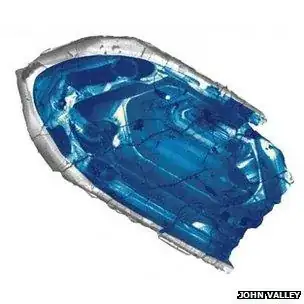The chances for a modern day space probe to survive for 1 gyr and be anything but a metalrich asteroid are quite slim. How slim exactly depends on its speed and that it doesn't run into any big debris out there. While debris are rare and space is quite empty there is always a chance for bad luck. Speed and time are the factors here. If you plot a smart course with several solar flybys a few percent of lightspeed are on the table. Needless to say that this makes collisions way worse as
Ekin = 0.5 * m * v^2.
Even a few atoms might degrade the probe significantly at high speeds. Of course lower speeds could help, yet I assume you want the probe to get somewhere within 1 gyr.
I'm not an expert on radiation induced material fatigue. Your probe will most likely suffer mostly from cosmic rays, but especially during solar flybys charged particle radiation will be an issue. Assume that the material will wither away over the eons.
Your worst issue on the radiation front will be the breakdown of computers though. Look up the design of computers on mars rovers like opportunity for example.
Less probable yet more intriguing story whise is data corruption. The mission (given more complex ai and some freedom to take decisions) statement might be "explore milky-way"; have some freak data corruption turn a r into a d and you have "explode milky-way". (Not very probable but an ai will do anything as long as it gets the reward circuit tickling).
So the answer is no.
BUT there might be a solution, albeit one using slightly future technologies.
Don't aim for longevity, aim for maintenance. Pick a big (maybe 10 to 100 m diameter), metalrich asteroid and turn the whole thing into a probe. Reinforce it structurally to get meters of radiation and impact shielding. Have huge databanks and really smart or slavishly dumb, yet specialised AI. Most importantly you need manufactories capable of producing anything on the asteriod probe and redundancies for every system.
For power you could employ a number of technologies. Nuclear reactors, (fusion or antimatter if available), radioisotope generators with an isotpe with a long (the desired mission time) half live, or solar panels during stellar flybys (you want to keep doing those as they counteract drag or slow you down if the system is interesting) (keep in mind that you can manufacture solar panels once you approach a system so the won't degrade). Generally beeing really conservative about using power will be helpfull as well. Let the probe hibernate during inter system flights and let it do the repair and exploration near stars where there is free energy and something to do.
Now you might wonder how to move such a kiloton behemoth to interstellar velocities, yet thats not so hard. Huge lightsails, laser thermal rockets, nuclear rockets or even ion drives will move it eventually. Then you simply need to plot a very smart flyby course arround moons planets and suns and you might cruise of at a not insignificant portion of lightspeed. Astronomer Paul Birch once said that one could theoretically throw a pebble into the asteroid belt and end up crashing mars into the sun.
Now even such a maintenance probe will run out of some resource (energy, ejection mass or raw materials) eventually or might degrade from collisions. (Come to think of it manufacturing, a huge thin mirror arround the probe when in a system seems highly beneficial. Use it as a high resolution telescope to scout out the system and the route ahead and use it as a solar sail to save ejection mass to get into an optimal gravity assist.) It is very conceivable that such a probe might survive for a billion years.
PS:Check out this video, it deals with constructing a spaceship for similar ammounts of time.
https://youtu.be/25ODAzr6Bbw
